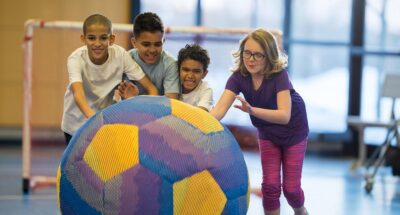

Module Introduction
SEL is foundational to Out of School Time (OST) programs, also referred to as Expanded Learning or Afterschool Programs. Expanded Learning can be defined as youth development programs that:
- provide a safe and supportive environment for learning
- focus on social, emotional, and academic development
- complement the regular school day
- increase learning time before or after the traditional school day or calendar
- leverage school and community resources
- connect and communicate with families
- assist with student and family needs
OST programs were, in many cases, one of the first settings to explicitly focus on social and emotional learning in the context of positive youth development. Schools and traditional school day educators can often learn a lot from Expanded Learning practitioners.
In this module, we will consider how out-of-school programming can complement in-school social and emotional learning.
We will:
- Reflect on the Eight Essential Practices for supporting SEL developed by the National Afterschool Association.
- Identify ways to align our SEL efforts across in-school and out-of-school time.
- Explore how to develop more authentic school-program partnerships that prioritize social and emotional skills.
Please note: Modules 4 and 5 are applicable to educators working in Out of School Time (OST) programs and other community-based organizations.
Module Resources
This toolkit includes additional resources, including classroom lessons and practices, staff meeting activities, videos, podcasts, articles, and professional development opportunities, as well as supporting materials for group facilitation on the topic of "Supporting SEL through Family and Community Engagement".
Individual Exploration
Eight Essential Practices for Expanded Learning
We start our exploration of Expanded Learning and social and emotional skills by reviewing the Eight Essential Practices suggested by the National Afterschool Association.
- Get in touch with your own social and emotional competencies.
- Acknowledge diverse characteristics of the community and other learning contexts.
- Plan for SEL.
- Build in coaching and reflection for continuous improvement.
- Understand social and emotional development so you can effectively support social and emotional growth.
- Create a safe and supporting environment that is warm and welcoming.
- Support belonging and positive relationships.
- Provide opportunities for voice, choice and leadership to engage youth in learning and development.
Reflection
- In what ways are these practices similar or different from those you would consider essential in-school?
- What are some of your and your school’s individual and collective strengths?
- Identify some areas for growth.
Connecting OST and the Traditional School Day through SEL
In a 2016 report, Finding Common Ground: Connecting Social-Emotional Learning During and Beyond the School Day, by Partnership for Children and Youth (PCY), a founding member of the project, not sharing a common language is identified as one barrier to aligned and consistent SEL for students:
“School day and expanded learning professionals can most effectively develop their students’ social-emotional skills when they work together, providing students with consistent social-emotional learning strategies and environments. Unfortunately, these educators don’t always speak the same language. Too often they fail to recognize their common purpose, in part because they use different terminology and operate in silos.”
Review this two page infographic by Partnership for Children and Youth and Project 360/365, that provides a simple framework for practitioners to understand the goals of SEL, and A Crosswalk Between the CDE Quality Standards for Expanded Learning with SEL competencies.
Next, watch the following video from Edutopia.
Scaffolding Academics with Social Emotional Skills in the Afterschool Space
Reflection
- What are your experiences with Expanded Learning, either as an educator coordinating with a program, an Expanded Learning practitioner, or parent/caregiver?
- After reading the quote from the Finding Common Ground report, what are your takeaways? Aside from lacking a shared language around SEL, can you identify other barriers to SEL alignment across settings?
- What did you notice in the two-page infographic and the video in terms of simplified language? What might be the benefits of using accessible SEL terms and simple practices when working across settings?
- If you have experience teaching in Expanded Learning settings, how does the setting influence instructional dynamics around SEL? What do you do differently in OST? Does teaching SEL feel more, or less effective in OST? Why?
- Wrap-up Group Question: As you consider your current work contexts, identify several ways you can intentionally coordinate across school and after-school settings.
Connecting School and Afterschool with Shared Practices (5:48 from Edutopia)
Reflection
- Which of the shared signature practices seemed most effective to you?
- Are any of these practices in place in your setting?
- What SEL competencies are addressed in each signature practice?
- How do these practices set students up for success in other areas of the program?
- What strategies would you use to implement shared practices in your setting?
In order to plan a successful SEL initiative, school and OST partners collaborate to:
- Collaboratively plan and implement integrated services
- Provide integrated supports that reflect the science of learning and development
- Prioritize equity
- Develop relationships so that partnerships are “more than transactional” and become authentically collaborative—with shared leadership and unity of purpose among staff
6.4 Take It Deeper: Building SEL across OST
Let’s deepen our understanding of building SEL across the school day and OST. Here is a downloadable pdf to help you.
Module Resources
This toolkit includes additional resources, including classroom lessons and practices, staff meeting activities, videos, podcasts, articles, and professional development opportunities, as well as supporting materials for group facilitation on the topic of "Supporting SEL through Family and Community Engagement".
A reflection activity to help you deepen your understanding of building SEL across the school day and OST.
Group Facilitation
Before facilitating groups, spend time in individual exploration in order to experience and embody the learning. And if you haven’t yet explored our introduction to SEL in California, make sure you explore those resources, too.
When facilitating groups, use the following resources:
This toolkit includes additional resources, including classroom lessons and practices, staff meeting activities, videos, podcasts, articles, and professional development opportunities, as well as supporting materials for group facilitation on the topic of "Supporting SEL through Family and Community Engagement".
A revisable, turnkey powerpoint slide deck to use for professional learning sessions on the topic of "Supporting SEL through Family and Community Engagement".
A powerpoint slide deck with welcoming and closing activities to include in professional learning sessions.
A reflection activity to help you deepen your understanding of building SEL across the school day and OST.
Additional Modules
Supporting SEL through Family and Community Engagement
- Module 6.1 Exploring Family and Community Engagement with an SEL Lens
- Module 6.2 Building Partnerships with and Honoring the Contributions of Diverse Families
- Module 6.3 Listening and Communicating Effectively with Families
- Module 6.4 Expanded Learning and SEL: Collaborating Across In-School and OST Contexts
- Module 6.5 Aligning around SEL Through Community Partnerships

Are you ready to build a kinder, happier school where everyone belongs? Join Greater Good Educators! Explore the science of well-being in a supportive community of educators from around the world. Registration is now open for the 2025-2026 school year!


Comments